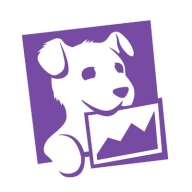

Datadog and StackPath Monitoring compete in performance monitoring and analytics. Datadog is favored for its comprehensive support and ease of use, while StackPath offers robust edge-focused features considered more cutting-edge by some.
Features: Datadog provides cloud monitoring, integrations across services, and advanced analytics and dashboards. StackPath Monitoring offers edge-focused solutions, reducing latency and improving service speed. Datadog's broader integration capabilities support diverse needs, while StackPath targets specific infrastructure with edge solutions.
Ease of Deployment and Customer Service: Datadog supports seamless cloud-based deployment with quick setup times and responsive service teams. StackPath Monitoring focuses on strong edge infrastructure deployment, requiring nuanced setup for peak performance. Both offer robust customer service, although Datadog is perceived as more user-friendly during initial setup phases.
Pricing and ROI: Datadog's pricing model allows scalability with pay-as-you-go options for higher ROI through customizable resource allocation. StackPath Monitoring has competitive setup costs appealing to businesses focused on edge computing, offering long-term value for specific applications. Datadog's flexible pricing often results in higher immediate ROI, whereas StackPath's tailored pricing may offer substantial benefits over time for targeted use cases.

Datadog is a comprehensive cloud monitoring platform designed to track performance, availability, and log aggregation for cloud resources like AWS, ECS, and Kubernetes. It offers robust tools for creating dashboards, observing user behavior, alerting, telemetry, security monitoring, and synthetic testing.
Datadog supports full observability across cloud providers and environments, enabling troubleshooting, error detection, and performance analysis to maintain system reliability. It offers detailed visualization of servers, integrates seamlessly with cloud providers like AWS, and provides powerful out-of-the-box dashboards and log analytics. Despite its strengths, users often note the need for better integration with other solutions and improved application-level insights. Common challenges include a complex pricing model, setup difficulties, and navigation issues. Users frequently mention the need for clearer documentation, faster loading times, enhanced error traceability, and better log management.
What are the key features of Datadog?
What benefits and ROI should users look for in reviews?
Datadog is implemented across different industries, from tech companies monitoring cloud applications to finance sectors ensuring transactional systems' performance. E-commerce platforms use Datadog to track and visualize user behavior and system health, while healthcare organizations utilize it for maintaining secure, compliant environments. Every implementation assists teams in customizing monitoring solutions specific to their industry's requirements.
We monitor all IT Infrastructure Monitoring reviews to prevent fraudulent reviews and keep review quality high. We do not post reviews by company employees or direct competitors. We validate each review for authenticity via cross-reference with LinkedIn, and personal follow-up with the reviewer when necessary.